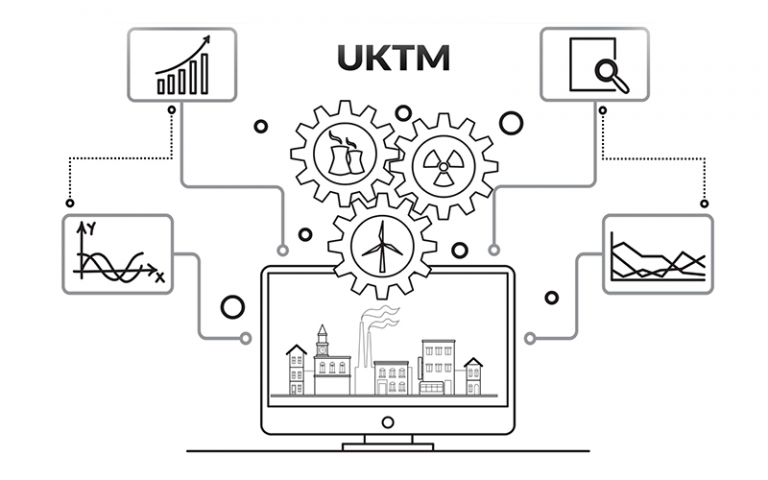UK TIMES: a model that underpins government climate policy
3 December 2021
Planning the route to a low-carbon economy in the UK is a complex task. Professor Paul Dodds explains how the UK TIMES Model created at UCL ISR in 2012 is used to help achieve this goal.

The Climate Change Act 2008 requires the UK government to reduce UK greenhouse gas emissions by 80% by 2050 compared to 1990 levels. In July 2019, the UK adopted a more ambitious net-zero emission target to meet its Paris Agreement commitment.
In 2021, the UK Government released its Net Zero Strategy. Such national climate strategies should identify coherent and cost-effective policies to credibly meet emission targets. They should ideally describe how each part of the economy should evolve at each stage of the transition to net zero.
The UK TIMES model
At UCL ISR, we created the UK TIMES energy system model in 2012 to explore the transition to a low-carbon economy in the UK. UK TIMES has a snapshot of the UK energy system in the year 2010, including all energy flows, technologies, and emissions. All emissions and their mitigation options outside the energy system were modelled for the first time, including those from agriculture, land use, refrigerants, and waste.
The energy system exists to meet energy service demands, such as heating, lighting and transport. For UK TIMES, we need to forecast how each energy service demand will change in the future.
We define a wide range of possible decarbonisation technologies in the model (e.g. renewable generation; hydrogen production and use; heat pumps to heat homes and offices). The model then calculates the cheapest possible way to meet all of the energy service demands, in a 50-year transition to the year 2060, while also meeting our greenhouse gas emission targets. It identifies investment strategies in a range of new technologies over the transition. These can then be put into practice by appropriate government policies.
Use of UK TIMES by the UK Government and other stakeholders
UK TIMES has been adopted by the UK government as their principal in-house tool for generating long-term energy scenarios. It directly contributed to their decision to adopt a net-zero target and underpinned the Net Zero Strategy, the Clean Growth Strategy, and their decisions to agree the fifth and sixth carbon budgets proposed by the Climate Change Committee.
In October 2017, the Department of Business, Industry and Industrial Strategy (BEIS) published the Clean Growth Strategy, which set out how the government planned to meet the Fourth and Fifth Carbon Budget commitments. BEIS used UK TIMES to explore scenarios for energy system decarbonisation, and to identify key energy technologies that could contribute to decarbonisation and provide growth opportunities.
For the Net Zero Strategy, BEIS used UK TIMES to create a range of internally consistent scenarios that met emission targets. Each part of those scenarios was then reviewed by the appropriate expert team in BEIS, or elsewhere in government (e.g. DEFRA for agriculture; DfT for transport). This helped BEIS to coordinate its various teams and inter-departmental stakeholders around a more coherent decarbonisation strategy.
National Grid have similarly adopted UK TIMES to provide evidence for their annual Future Energy Scenarios for the last few years. ISR has created a UK TIMES expert user group that meets annually and includes 20 stakeholders from government, business and academia. Academics are able to join the expert user group and use the model.
The future of the UK TIMES model
UK TIMES is continually being improved as we learn more about novel low-carbon technologies, and consider how we can more accurately represent the UK energy system in the model.
UK TIMES represents the whole UK as a single region. UCL are working with BEIS to develop a new multi-region version that will enable us to explore the implications of different parts of the UK adopting different policies to achieve decarbonisation targets (e.g. if England invests in nuclear power while Scotland looks to offshore renewables).
In the longer term, we would like to take this further by modelling each local government region separately so we can produce local decarbonisation plans. These would reflect the characteristics of each local area while ensuring that the sum of all of the plans across the country would achieve net zero.
We are exploring how we can use UK TIMES in novel ways. One example is to consider how the transition pathways might change if energy service demands were to substantially reduce in the future as a result of widespread behavioural change. Another is to use different types of uncertainty analyses to explore the range of potential future pathways, and to understand which of these are most plausible from a socio-political perspective.
While UK TIMES is already available to the expert user group, we are keen to make the new model completely open source. It will soon be hosted on a website with full documentation. We also hope to make key transition scenarios available to the public via a new website. Watch this space!
Photo by Fred Rivett on Unsplash
 Close
Close

